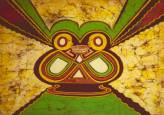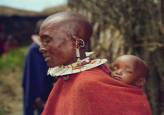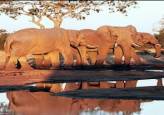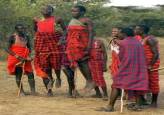|
----------------------------------------------------------------------------------------
Types
Of Art:
 Maasai
are best known for their beautiful beadwork
which plays an essential element in the
ornamentation of the body. Beading patterns are
determined by each age-set and identify grades.
Young men, who often cover their bodies in ocher
to enhance their appearance, may spend hours and
days working on ornate hairstyles, which are
ritually shaved as they pass into the next
age-grade. Maasai
are best known for their beautiful beadwork
which plays an essential element in the
ornamentation of the body. Beading patterns are
determined by each age-set and identify grades.
Young men, who often cover their bodies in ocher
to enhance their appearance, may spend hours and
days working on ornate hairstyles, which are
ritually shaved as they pass into the next
age-grade.
----------------------------------------------------------------------------------------
History:
 Maasai
are the southernmost Nilotic speakers and are
linguistically most directly related to the
Turkana and Kalenjin who live near Lake Turkana
in west central Kenya. According to Maasai oral
history and the archaeological record, they also
originated near Lake Turkana. Maasai are
pastoralist and have resisted the urging of the
Tanzanian and Kenyan governments to adopt a more
sedentary lifestyle. They have demanded grazing
rights to many of the national parks in both
countries and routinely ignore international
boundaries as they move their great cattle herds
across the open savanna with the changing of the
seasons. This resistance has led to a
romanticizing of the Maasai way of life that
paints them as living at peace with nature. Maasai
are the southernmost Nilotic speakers and are
linguistically most directly related to the
Turkana and Kalenjin who live near Lake Turkana
in west central Kenya. According to Maasai oral
history and the archaeological record, they also
originated near Lake Turkana. Maasai are
pastoralist and have resisted the urging of the
Tanzanian and Kenyan governments to adopt a more
sedentary lifestyle. They have demanded grazing
rights to many of the national parks in both
countries and routinely ignore international
boundaries as they move their great cattle herds
across the open savanna with the changing of the
seasons. This resistance has led to a
romanticizing of the Maasai way of life that
paints them as living at peace with nature.
----------------------------------------------------------------------------------------
Economy:
 Cattle
are central to Maasai economy. They are rarely
killed, but instead are accumulated as a sign of
wealth and traded or sold to settle debts. Their
traditional grazing lands span from central
Kenya into central Tanzania. Young men are
responsible for tending to the herds and often
live in small camps, moving frequently in the
constant search for water and good grazing
lands. Maasai are ruthless capitalists and due
to past behavior have become notorious as cattle
rustlers. At one time young Maasai warriors set
off in groups with the express purpose of
acquiring illegal cattle. Maasai often travel
into towns and cities to purchase goods and
supplies and to sell their cattle at regional
markets. Maasai also sell their beautiful
beadwork to the tourists with whom they share
their grazing land. Cattle
are central to Maasai economy. They are rarely
killed, but instead are accumulated as a sign of
wealth and traded or sold to settle debts. Their
traditional grazing lands span from central
Kenya into central Tanzania. Young men are
responsible for tending to the herds and often
live in small camps, moving frequently in the
constant search for water and good grazing
lands. Maasai are ruthless capitalists and due
to past behavior have become notorious as cattle
rustlers. At one time young Maasai warriors set
off in groups with the express purpose of
acquiring illegal cattle. Maasai often travel
into towns and cities to purchase goods and
supplies and to sell their cattle at regional
markets. Maasai also sell their beautiful
beadwork to the tourists with whom they share
their grazing land.
----------------------------------------------------------------------------------------
Political
Systems:
 Maasai
community politics are embedded in age-grade
systems which separate young men and
prepubescent girls from the elder men and their
wives and children. When a young woman reaches
puberty she is usually married immediately to an
older man. Until this time, however, she may
live and have sex with the youthful warriors.
Often women maintain close ties, both social and
sexual, with their former boyfriends, even after
they are married. In order for men to marry they
must first acquire wealth, a process that takes
time. Women, on the other hand, are married at
the onset of puberty to prevent children being
born out of wedlock. All children, whether
legitimate are not, are recognized as the
property of the woman's husband and his family. Maasai
community politics are embedded in age-grade
systems which separate young men and
prepubescent girls from the elder men and their
wives and children. When a young woman reaches
puberty she is usually married immediately to an
older man. Until this time, however, she may
live and have sex with the youthful warriors.
Often women maintain close ties, both social and
sexual, with their former boyfriends, even after
they are married. In order for men to marry they
must first acquire wealth, a process that takes
time. Women, on the other hand, are married at
the onset of puberty to prevent children being
born out of wedlock. All children, whether
legitimate are not, are recognized as the
property of the woman's husband and his family.
----------------------------------------------------------------------------------------
Religion:
 The
cow is slaughtered as an offering during
important ceremonies marking completed passage
through one age-grade and movement to the next.
When warriors (moran) complete this cycle of
life, they exhibit outward signs of sadness,
crying over the loss of their youth and
adventurous lifestyles. Maasai diviners (laibon)
are consulted whenever misfortune arises. They
also serve as healers, dispensing their herbal
remedies to treat physical ailment and ritual
treatments to absolve social and moral
transgressions. In recent years Maasai laibon
have earned a reputation as the best healers in
Tanzania. Even as western biomedicine gains
ground, people also continually search out more
traditional remedies. Maasai are often portrayed
as people who have not forgotten the importance
of the past, and as such their knowledge of
traditional healing ways has earned them
respect. Laibons are easily found peddling their
knowledge and herbs in the urban centers of
Tanzania and Kenya. The
cow is slaughtered as an offering during
important ceremonies marking completed passage
through one age-grade and movement to the next.
When warriors (moran) complete this cycle of
life, they exhibit outward signs of sadness,
crying over the loss of their youth and
adventurous lifestyles. Maasai diviners (laibon)
are consulted whenever misfortune arises. They
also serve as healers, dispensing their herbal
remedies to treat physical ailment and ritual
treatments to absolve social and moral
transgressions. In recent years Maasai laibon
have earned a reputation as the best healers in
Tanzania. Even as western biomedicine gains
ground, people also continually search out more
traditional remedies. Maasai are often portrayed
as people who have not forgotten the importance
of the past, and as such their knowledge of
traditional healing ways has earned them
respect. Laibons are easily found peddling their
knowledge and herbs in the urban centers of
Tanzania and Kenya.
----------------------------------------------------------------------------------------
|
